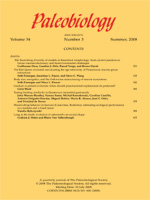A new sampling technique for fossil bone (coring with a 5/8” bit) was used to sample longbones of all four sauropod genera from the Upper Jurassic Tendaguru beds of Tanzania for paleohistological study. Brachiosaurus and Barosaurus are represented by growth series of humeri and femora, while Dicraeosaurus could be sampled in fewer specimens and only one bone of Janenschia was available. Although all samples are dominated by fibrolamellar bone tissue, taxa can be distinguished by the degree and nature of bone remodeling and the presence and spacing of a peculiar kind of growth line (here termed “polish lines”). In addition, Barosaurus bone revealed two types of histology, tentatively interpreted as sexual morphs. The Tendaguru sauropods show a common growth pattern in which growth is determinate but sexual maturity is achieved well before maximum size is reached. For Brachiosaurus and Barosaurus, size at sexual maturity can be estimated and was reached at about 40% and 70% maximum size, respectively. Quantification of growth is possible in Janenschia using polish lines: the specimen studied reached sexual maturity at ≥11 years, attained maximum size at ≥26 years, and died at ≥38 years.
How to translate text using browser tools
1 September 2000
Longbone histology of the Tendaguru sauropods: implications for growth and biology
P. Martin Sander
ACCESS THE FULL ARTICLE

Paleobiology
Vol. 26 • No. 3
September 2000
Vol. 26 • No. 3
September 2000




